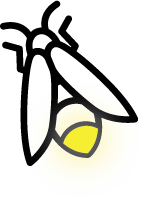
The Town of Newmarket has a designated area as the Firefly Marsh, located on the trail west of the Magna Centre. There you can see the sparkle of fireflies in the summer nights. Fireflies are actually beetles and their sparkle is called bioluminescence, a chemical reaction that causes the lower part of their abdomen to emit light.
Each species of firefly has its own unique patterning of flashes and flickers and they emit light to attract a mate and to scare off predators. Fireflies represent the magic of nature, the memories of our youth and no matter how old we get, seeing fireflies light up the night will always put a smile on your face.

Fireflies and Indigenous History
Fireflies also have a rich history with Indigenous Peoples. There are many stories about the significance of the firefly within Indigenous cultures; signalling such things as timing for hunting and gathering certain animals and plants in a manner that respects those species and fosters a healthy balance with Mother Earth. This knowledge system represents in essence, the human connection with nature. Understanding our role as part of Mother Earth and maintaining a healthy, respectful, reciprocal relationship with her is the foundation for indigenous cultures worldwide. The Indigenous Peoples who have inhabited this land have been learning and applying this wisdom of Traditional Knowledge for millennia. This knowledge in combination with what we have discovered through modern science will help us to understand how best to protect natural places like Firefly Marsh. The fireflies of Firefly Marsh are a beautiful reminder of our connection with nature, and the need to respect and conserve its magic.
Source: Kerry Ann Charles-Norris, Environment Partnership Co-Ordinator, Cambium Indigenous Professional Services
How can you help?
Despite their sparkle and popularity, Firefly populations are in decline. There are many threats to fireflies, however there are also easy ways for you to help keep their magic alive!
Conserving natural areas like Firefly Marsh and keeping them healthy is vital to fireflies.
- Stay on marked trails. A simple wander of trail can trample firefly and other species living in the leaf litter on the ground.
- Don't litter, even small amounts can have a negative impact on nature.
- Speak up about protecting natural areas, your voice may be small, but it is powerful!
Limit light pollution
Artificial outdoor light from nearby homes and businesses affects the Fireflies during their breeding and mating, while they are doing their own light show. Their bioluminescence helps them communicate with each other for mating, and also repels predators. Artificial lights interfere with their ability to find a mate, and makes them vulnerable to predators as they won't shine as brightly as they are competing with the all the other light.
- Turning off your outdoor lights on a summer night might even bring the fireflies to your own backyard!
- Encourage local business to use less outdoor light in the summer months
Choose natural fertilizers over synthetic to help the fireflies
Pesticides, fertilizers, salt, oil, grease, car washing, and other contaminants are harmful to fireflies, and many other amazing species. These contaminants make their way to Firefly Marsh, and other natural areas, from run off from your driveway, lawn and garden when it rains, or when the snow melts. The added bonus is that these will also improve your lawn's soil, which is key for a healthy, great looking lawn!
Be smart about the salt you use in the winter. Use minimal salt or consider non-toxic alternatives. This will help the fireflies, and will also protect our local waterways, groundwater and drinking water.
Consider planting some of our many beautiful native shrubs, trees and plants in your yard
- Fireflies rely on their natural habitats and the native species for their survival. When invasive species take over, their habitat changes, and they lose the food and shelter they rely on.
- Avoid planting invasive species, especially near natural areas.
Leave fallen leaves around your property for the winter and early spring
Firefly adults and larva (the young fireflies) spend their winter hibernating in leaf litter, which keeps them warm and protected throughout the winter, so they can resume their sparkling night show the following summer. Clearing of leaves from lawns and gardens removes the areas where they can safely hibernate for the winter.
This will benefit the fireflies, but it is also protecting many other beneficial insects and pollinators. The blanket of leaves will also protect your plants, their roots and soil, making for a much healthier garden for you next year!
Source: Firefly Conservation: Conserving the Jewels of the Night | Xerces Society